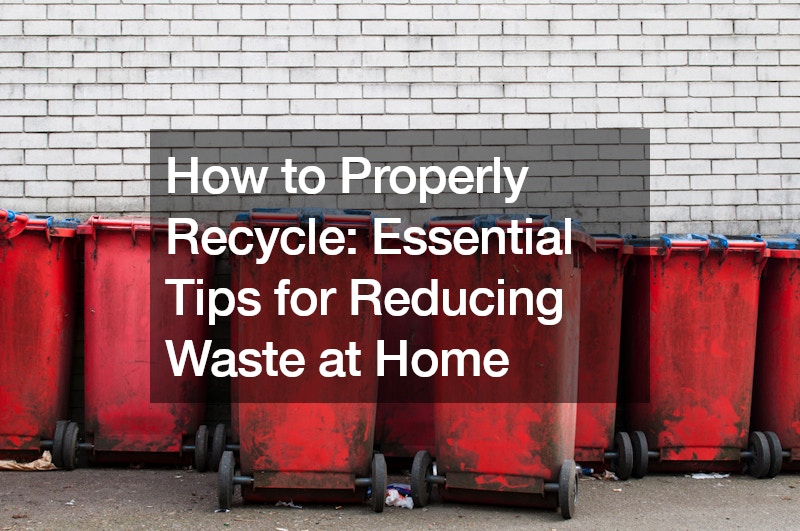Recycling is more than just tossing items into a bin marked with the familiar three-arrow symbol. It’s a crucial step in reducing waste and conserving resources for a sustainable future. However, navigating the world of recycling can be confusing, with different rules and practices in place depending on where you live. To help simplify the process and ensure that your recycling efforts are effective, here are some essential tips for proper waste management at home.
Understanding the Basics of Recycling
Before delving into recycling practices, it’s essential to understand the fundamentals. Recycling involves collecting and processing materials such as paper, plastic, glass, and metal to create new products.
By recycling, we can conserve natural resources, reduce energy consumption, and minimize pollution.
Common Recycling Mistakes
Despite its importance, recycling is often misunderstood, leading to common mistakes that can hinder the process. One prevalent error is wishcycling, where individuals mistakenly place non-recyclable items in recycling bins. This practice can contaminate recyclable materials and disrupt the waste collection process.
Identifying Recyclable Materials
To recycle effectively, it’s crucial to know which materials are accepted in your area. While items like paper, cardboard, aluminum cans, and certain types of plastic are widely recyclable, others, such as batteries and plastic bags, are not suitable for standard recycling programs.
Cleaning and Preparing Recyclables
Before placing items in the recycling bin, it’s essential to clean and prepare them properly. Food residue or grease can contaminate recyclable materials, rendering them unfit for recycling. Rinse containers and remove any food or liquid residue to ensure they are clean and ready for recycling.
Understanding Local Recycling Guidelines
Each municipality or region may have its own set of recycling guidelines and practices. It’s essential to familiarize yourself with these guidelines to ensure compliance and maximize the effectiveness of your recycling efforts. Check with your local waste collection provider or visit their website for information on accepted materials and recycling procedures.
Reducing Contamination
Contamination is a significant challenge in the recycling process, as even small amounts of non-recyclable materials can render entire batches of recyclables unusable. To reduce contamination, avoid placing items such as plastic bags, tanglers (items that can tangle in recycling machinery), and hazardous materials in recycling bins.
Proper Disposal of Hazardous Materials
Certain items, such as batteries, electronics, and household chemicals, require special disposal methods due to their hazardous nature. These items should not be placed in regular recycling bins but instead taken to designated drop-off locations or waste collection events for proper disposal.
Advocating for Improved Recycling Practices
As individuals, we can also advocate for improved recycling practices in our communities. By engaging with local authorities, businesses, and waste management agencies, we can support initiatives aimed at expanding recycling programs, increasing public awareness, and reducing waste generation.
Community Recycling Programs
Community-based recycling programs play a crucial role in promoting sustainable waste management practices and reducing the burden on landfills. These programs often include curbside recycling pickup services, community drop-off centers, and recycling education initiatives. Curbside recycling allows residents to conveniently dispose of recyclable materials alongside their regular waste collection, encouraging widespread participation and diverting recyclables from landfills. Community drop-off centers provide additional options for recycling items that may not be accepted through curbside pickup, such as electronics, textiles, and hazardous waste. Recycling education efforts help raise awareness about the importance of recycling, teach proper sorting techniques, and encourage residents to reduce waste generation through practices like composting and reuse. By actively participating in community recycling programs, individuals can contribute to local sustainability efforts and make a positive impact on the environment.
Educational Outreach
Education and outreach play a crucial role in promoting recycling and fostering environmentally responsible behaviors among individuals and communities. By increasing awareness about the benefits of recycling, the importance of waste reduction, and the proper methods of disposal, educational initiatives empower people to make informed decisions and take positive environmental actions. Educational outreach efforts may include public awareness campaigns, school programs, workshops, and community events focused on recycling and waste management. These initiatives aim to engage people of all ages and backgrounds, providing them with the knowledge and resources they need to adopt sustainable practices in their daily lives. By investing in education and outreach, communities can inspire behavior change, reduce contamination in recycling streams, and increase participation in recycling programs, ultimately contributing to a cleaner and healthier environment for present and future generations.
Embracing the Reduce, Reuse, Recycle Mindset
Ultimately, effective recycling is just one part of a broader approach to waste management. Embracing the reduce, reuse, recycle mindset can help minimize waste generation and maximize resource conservation. By reducing consumption, reusing items whenever possible, and recycling responsibly, we can all contribute to a cleaner, greener future.
Conclusion
Proper recycling is essential for reducing waste, conserving resources, and protecting the environment. By understanding the basics of recycling, avoiding common mistakes, and following local guidelines, we can all play a role in creating a more sustainable world. Let’s commit to proper waste management practices and work together to build a cleaner, healthier future for generations to come.
.











